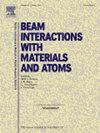Graphitization efficiency of small-sized carbon samples and its impact on 14C/12C and 13C/12C isotope ratios
IF 1.4
3区 物理与天体物理
Q3 INSTRUMENTS & INSTRUMENTATION
Nuclear Instruments & Methods in Physics Research Section B-beam Interactions With Materials and Atoms
Pub Date : 2025-01-31
DOI:10.1016/j.nimb.2025.165632
引用次数: 0
Abstract
The Mini Carbon Dating System and Automated Graphitization Equipment, developed by Ionplus AG, were specifically designed for radiocarbon isotope ratio testing and for graphite synthesis with one milligram of carbon. Here, we carefully weighed standard samples of NIST-SRM-4990C, phthalic acid and IAEA-C7, with carbon masses ranging from 30 to 1000 μg, for graphitization, 14C/12C and 13C/12C isotope ratio measurement. The results showed a positive correlation between graphitization efficiency and carbon size, with efficiencies surpassing about 70 % and 90 % when the carbon content exceeded approximately 200 and 400 μg, respectively. Moreover, the δ13C values of the graphite product indicated the presence of carbon isotope fractionation during the graphitization processes, which was particularly pronounced when the carbon content was below 200 μg. Accordingly, we recommend that the graphite content should exceed 200 μg for reliable radiocarbon measurements.
求助全文
约1分钟内获得全文
求助全文
来源期刊
CiteScore
2.80
自引率
7.70%
发文量
231
审稿时长
1.9 months
期刊介绍:
Section B of Nuclear Instruments and Methods in Physics Research covers all aspects of the interaction of energetic beams with atoms, molecules and aggregate forms of matter. This includes ion beam analysis and ion beam modification of materials as well as basic data of importance for these studies. Topics of general interest include: atomic collisions in solids, particle channelling, all aspects of collision cascades, the modification of materials by energetic beams, ion implantation, irradiation - induced changes in materials, the physics and chemistry of beam interactions and the analysis of materials by all forms of energetic radiation. Modification by ion, laser and electron beams for the study of electronic materials, metals, ceramics, insulators, polymers and other important and new materials systems are included. Related studies, such as the application of ion beam analysis to biological, archaeological and geological samples as well as applications to solve problems in planetary science are also welcome. Energetic beams of interest include atomic and molecular ions, neutrons, positrons and muons, plasmas directed at surfaces, electron and photon beams, including laser treated surfaces and studies of solids by photon radiation from rotating anodes, synchrotrons, etc. In addition, the interaction between various forms of radiation and radiation-induced deposition processes are relevant.

 求助内容:
求助内容: 应助结果提醒方式:
应助结果提醒方式:


